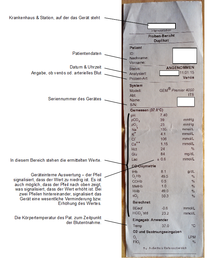Blood gas analysis
The blood gas analysis (short BGA , sometimes under the eponym Astrup by Poul Bjørndahl Astrup is known) a method for measuring the gas distribution ( partial pressure ) of O 2 ( oxygen ), CO 2 ( carbon dioxide ) as well as the pH and acid-base -Household in the blood .
The BGA goes back to the need to monitor and control ventilation parameters and was developed in its basic form in the 1960s. Blood gas analysis is an important part of clinical diagnostics today. Over the years, other analytes and calculated parameters have been added to the classic acid-base balance: hemoglobin , hemoglobin derivatives, bicarbonate , glucose , lactate , electrolytes , etc.
Blood gas analysis is now used to monitor many patients with breathing disorders and a lack of oxygen (for example with chronic obstructive pulmonary disease or cystic fibrosis ). In the intensive care unit , in the surgical and anesthesia department and in the emergency room of a hospital blood gas analysis is usually "bedside" - bedside performed (in immediate patient vicinity). The BGA is also becoming increasingly important in emergency medicine , for example in the context of resuscitation , and is not only carried during intensive care transport but also on some emergency medical vehicles . For this purpose, arterial whole blood from an artery or arterialized capillary blood, for example from the hyperaemized earlobe, is preferably used. Venous blood is only suitable to a limited extent for assessing respiratory-specific values and is mainly used for assessing metabolic components.
Normal values (arterial) in adults
- pH = 7.35-7.45; <7.35: acidosis ; > 7.45: alkalosis
- pO 2 = 75–97 mmHg or 10–12.9 kPa (depending on age)
- s a O 2 = 95-99% ( oxygen saturation )
- pCO 2 = 35-45 mmHg or 4.6-6.0 kPa (carbon dioxide partial pressure ); less: hypocapnia ; more: hypercapnia
- HCO 3 (act) = 21–26 mmol / l (actual bicarbonate )
- HCO 3 (std) = 23-27 mmol / l (standard bicarbonate)
- BE ( base excess , base deviation or base excess ) = 0 meq / l (−2 to +3 mmol / l)
Normal values (newborns / infants / children)
- pH = 7.20-7.41 (newborn 1st day)
- pH = 7.34–7.45 (newborns 2–28 days)
- pH = 7.38–7.45 (infant 2–12 months)
- pCO 2 = 29-61 mmHg (4.0-8.0 kPa) (newborn 1st day)
- pCO 2 = 26–43 mmHg (3.5–5.7 kPa) (newborn 2–28 days)
- pCO 2 = 27-40 mmHg (3.6-5.3 kPa) (infant 2-12 months)
- pO 2 = 16–35 mmHg (2.2–4.7 kPa) ( umbilical vein )
- pO 2 = 70–85 mmHg (9.3–11.4 kPa) (newborn 2–28 days)
interpretation
A pH value below 7.35 corresponds to acidosis , a pH value above 7.45 corresponds to alkalosis . If the change is primarily caused by a change in pCO 2 , it is referred to as a (breathing-related) respiratory disorder. Carbon dioxide represents a “volatile acid”. An increase in pCO 2 (hypoventilation) consequently leads to respiratory acidosis, a decrease (hyperventilation) leads to respiratory alkalosis.
Bicarbonate is the associated base. Disorders in which the bicarbonate concentration is primarily changed are called metabolic (metabolism-related) disorders. A decrease in bicarbonate is characteristic of metabolic acidosis, an increase in metabolic alkalosis. After a sprint, for example, the lactate concentration can rise due to the lack of oxygen that may arise. Lactic acid dissociates completely, the protons are buffered by bicarbonate ions, the concentration of which drops. The buffering is not complete; metabolic acidosis occurs, which is a common disturbance in the acid-base balance.
See also
Web links
- Blood gas analysis, introduction for nursing staff ( Memento from January 30, 2010 in the Internet Archive )
- Basic article blood gas analysis
- Intensivbert.de Intensive care and anesthesia
- Python algorithm for analyzing blood gases
- An interpretation aid for the acid-base balance .
Individual evidence
- ^ A b Hans Walter Striebel: Anesthesia Intensive Care Medicine - Emergency Medicine: For Study and Training, p. 553 . Schattauer Verlag, Stuttgart 2008, ISBN 978-3-7945-2635-2 . Online: limited preview in Google Book search

